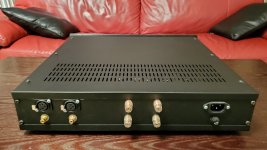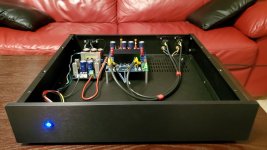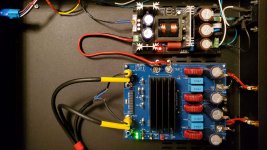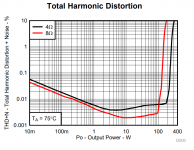Hi,Yes, you're right! But there are not any for a PBTL configuration, which I would use in a dual monoblock design. From what I can find elsewhere it seems that 8 ohm loads and a PBTL configuration is unusual. Again, with the right LP-filter it would probably work just fine, but do you know if it will affect audio quality? Also, I'm guessing PBTL and 8 Ohm loads is a bit inefficient - is this true?
If you follow the trend of the THD curves for 1ohm, 2ohm, and 4ohm, the THD curves decrease in THD for an increase in load resistance. Hence as per the 8ohm THD curve front page, and page 10, i would expect that the 8ohm load has the better THD. You could ask on the TI Forum about this.
Regards,
Shadders.
TAS5630B ? Digi-Key have 5 in Sweden
Hi everyone! I'm an electronics student from Umeå (Sweden) and I'm currently planning out a project in a PCB course that I'm taking. I'm really excited because I'm allowed to build an amplifier with the TPA3255!! The only downside is that (as you probalby know... ) they are not available on Digi-key, Mouser or anywhere else. So I was thinking, since I have access to a soldering lab, that I could buy a used amplifier and take the chip from there. Buuut, I can't find a used amplifier either...
So I'm wondering if anyone has any tips for me regarding finding a TPA3255 or a suitable replacement. I'm aiming for a stereo class D amplifier that could deliver ~100W into 8Ohms with a THD+N < 1% and an SNR > 115dB. I know these are some difficult goals to reach, but TI has two great papers that I've read on output LP-filters and PFFB for the TPA3255, which is why I choose this IC. It will probably still be difficult, but aim for the stars and land on the moon! An option could also be to find a less powerfull IC and build a dual monoblock amplifier with the IC in a PBTL configuration.
I'm thankfull for any tips I can get!!
PS. It's hard to be a student when you can't find any parts :'(
Good analysis! I will look in to it.Hi,
If you follow the trend of the THD curves for 1ohm, 2ohm, and 4ohm, the THD curves decrease in THD for an increase in load resistance. Hence as per the 8ohm THD curve front page, and page 10, i would expect that the 8ohm load has the better THD. You could ask on the TI Forum about this.
Regards,
Shadders.
A million thanks for your help shadders!
Interesting! A bit older, but big power - I like it!TAS5630B ? Digi-Key have 5 in Sweden
Tack tack 🙂
Did you get that PSU from Aliexpress? How did you like? Any problems for you? Where did you get the case?If anybody interested:
https://www.ebay.com/itm/255511886392
PSU was from eBay. Probably the same as Aliexpress. It is well made and stable. Didn't have any problems with it yet. The case was directly ordered from Italian company.Did you get that PSU from Aliexpress? How did you like? Any problems for you? Where did you get the case?
Did you ever bench test your setup? What kind of power ratings did you see at 4 and 8 ohm?PSU was from eBay. Probably the same as Aliexpress. It is well made and stable. Didn't have any problems with it yet. The case was directly ordered from Italian company.
If you want to use it as a reference I would stay under 100W at 8ohm and 200W at 4ohm.Did you ever bench test your setup? What kind of power ratings did you see at 4 and 8 ohm?
Attachments
A question that's arisen in another thread. Can you bridge the two outputs of a stereo TPA325x amplifier, by using an audio transformer on one input & connecting the load between the two +ve terminals? In other words, can you bridge two outputs which themselves are already a BTL of two SE outputs?
Yes you can connect the four half bridges to drive one output, but you don't need a transformer. Use PBTL, there's an application example on page 28 in the data sheet.A question that's arisen in another thread. Can you bridge the two outputs of a stereo TPA325x amplifier, by using an audio transformer on one input & connecting the load between the two +ve terminals? In other words, can you bridge two outputs which themselves are already a BTL of two SE outputs?
Yes you can connect the four half bridges to drive one output, but you don't need a transformer. Use PBTL, there's an application example on page 28 in the data sheet.
I should have specified that I’m trying to drive an 8 ohm load. My understanding is that PBTL with these amps is pointless for 8 ohm due to the current limit?
Instead of viewing misleading YT videos produced by noobs it is more helpful to study the original data sheets and applications. All these TPA-32xx can by wired in PBTL bridge mode with the effect that the power of 2 stereo channels is available at a single mono output. This requires in fact a symmetrical input signal. You may use a transformer or operational amps to achieve this.I should have specified that I’m trying to drive an 8 ohm load. My understanding is that PBTL with these amps is pointless for 8 ohm due to the current limit?
I cannot comment on the details of your Ayima as I do build my amps from scratch. But I can assure you this works in real world.
Instead of viewing misleading YT videos produced by noobs it is more helpful to study the original data sheets and applications. All these TPA-32xx can by wired in PBTL bridge mode with the effect that the power of 2 stereo channels is available at a single mono output. This requires in fact a symmetrical input signal. You may use a transformer or operational amps to achieve this.
I cannot comment on the details of your Ayima as I do build my amps from scratch. But I can assure you this works in real world.
If you'd actually looked at that other thread properly, you'd have noticed that I was the one who highlighted that the YouTube video is misleading, that it certainly isn't bridging the amp & explained to the person who posted it that the TPA325x are four SE amps that can run in PBTL for mono applications.
The question I brought to this thread still stands though. With the TPA325x in PBTL mode driving an 8 ohm load, my understanding is that you will hit the current limit of each BTL before gaining any extra power. This is presumably why the data sheet (which I have spent plenty of time studying) doesn't specify performance details for 8 ohms in sections 7.8 or 7.11 on PBTL characteristics, but only 2, 3 & 4 ohms.
By parallelling the outputs you increase CURRENT capabilities of the amp making it possible to drive low impedance down to 2 ohms. With a fixed supply voltage the max output VOLTAGE swing nearly stays the same - so you do not gain significant power into 8 Ohms. On the other hand conduction losses are reduced by paralleling so you can shrink the heat sink significantly.If you'd actually looked at that other thread properly, you'd have noticed that I was the one who highlighted that the YouTube video is misleading, that it certainly isn't bridging the amp & explained to the person who posted it that the TPA325x are four SE amps that can run in PBTL for mono applications.
The question I brought to this thread still stands though. With the TPA325x in PBTL mode driving an 8 ohm load, my understanding is that you will hit the current limit of each BTL before gaining any extra power. This is presumably why the data sheet (which I have spent plenty of time studying) doesn't specify performance details for 8 ohms in sections 7.8 or 7.11 on PBTL characteristics, but only 2, 3 & 4 ohms.
Current limiting in that case is certainly not the limiting factor.
If you really want to boost output you either increase supply voltage and/or use a (bulky) stepup output transformer.
By parallelling the outputs you increase CURRENT capabilities of the amp making it possible to drive low impedance down to 2 ohms. With a fixed supply voltage the max output VOLTAGE swing nearly stays the same - so you do not gain significant power into 8 Ohms. On the other hand conduction losses are reduced by paralleling so you can shrink the heat sink significantly.
Current limiting in that case is certainly not the limiting factor.
If you really want to boost output you either increase supply voltage and/or use a (bulky) stepup output transformer.
Yes, I understand that paralleling increases available output current while bridging increases the available voltage swing.
I think my question comes down to how the limit of the available rail voltage & current handling will bottleneck performance into a mono 8 ohm load depending upon how we connect the two BTLs.
If we drive an 8 ohm load using PBTL, each BTL will effectively see a 16 ohm load & each SE will effectively see a 8 ohm load. The datasheet does not specify any performance values for this operation, but if we extrapolate from the rated SE performance for a 4 ohm load at 1% THD with PVDD = 53.5V of 77W, we can assume roughy 40W for 8 ohm SE, so perhaps 160W total into our 8 ohm PBTL load.
If however we drive the same 8 ohm load by bridging the two BTLs, each BTL will effectively see a 4 ohm load & each SE will effectively see a 2 ohm load. The datasheet specifies 120W for 2 ohm SE (at the same 1% THD & 53.5V PVDD) & 255W for 4 ohm BTL. This would presumably give us >400W into our 8 ohm bridged load.
This is a big difference, so unless that >400W bridged output would actually be limited by some bottleneck that my calculations haven’t considered, the bridged approach would be far more preferable than PBTL? Presumably the issue is that bridging the BTLs just gets limited by the rail voltage?
Last edited:
There is only one way to connect two BTLs, and that is parallelling them to PBTL. I understand you suggest to bridge 2 bridges, i.e. wire them in series. This could be done theoretically requiring two isolated supplies and two floating, symm inputs. I would expect a bunch of new practical problems this way and did not see any real attempts into this direction until now.
Last edited:
Okay that is the missing piece - bridging the BTLs can’t be done.
In that case, still assuming a single 8 ohm load, is there any benefit to running a TPA3255 in 1x PBTL output configuration compared to running it in 1x BTL output configuration with channel CD not switching? Will there be any difference in THD?
In that case, still assuming a single 8 ohm load, is there any benefit to running a TPA3255 in 1x PBTL output configuration compared to running it in 1x BTL output configuration with channel CD not switching? Will there be any difference in THD?
yes, some speakers that are listed as 8 ohms may have very low impedance at certain frequencies and are typically reviewed as difficult to drive speakers. Using the PBTL configuration may help in these limited situations. THD will vary with the choice of output inductors and if Post filter feedback is used or not. If you are chasing decimal points, layout, component selection and placement are all important as well.
There are minor advantage in THD to be expected with the PBTL solution. As I mentioned above, a more relevant difference is halving the power loss inside the chip resulting in a tiny heatsink. All in all I consider the PBTL-mono configuration the best in terms of THD, power-loss=efficiency and ruggedness.Okay that is the missing piece - bridging the BTLs can’t be done.
In that case, still assuming a single 8 ohm load, is there any benefit to running a TPA3255 in 1x PBTL output configuration compared to running it in 1x BTL output configuration with channel CD not switching? Will there be any difference in THD?
I’m building the 3e Tpa3255 amp to power a pair of 4ohm speakers and I can get a good deal locally on the Meanwell Rps400-48 for about $50. My other option is a Connex SMPS600RS for a lot more money. Is the Connex worth the extra money?
- Home
- Amplifiers
- Class D
- TPA3255 - all about DIY, Discussion, Design etc





